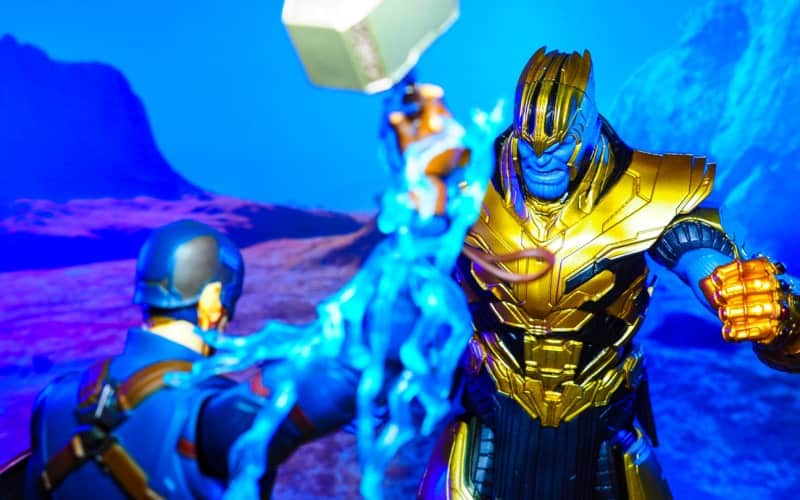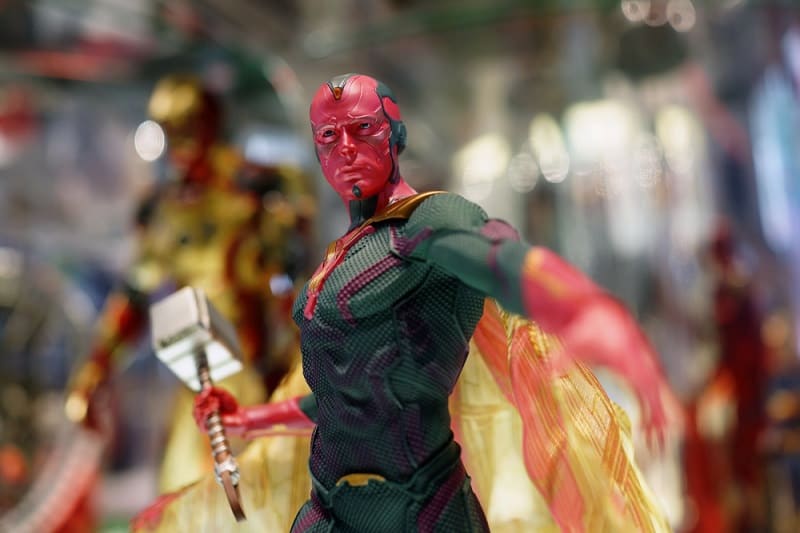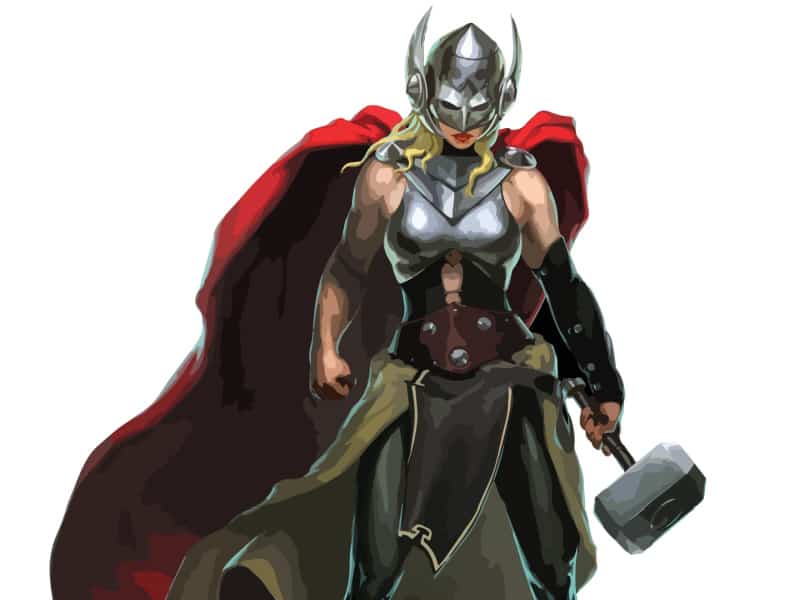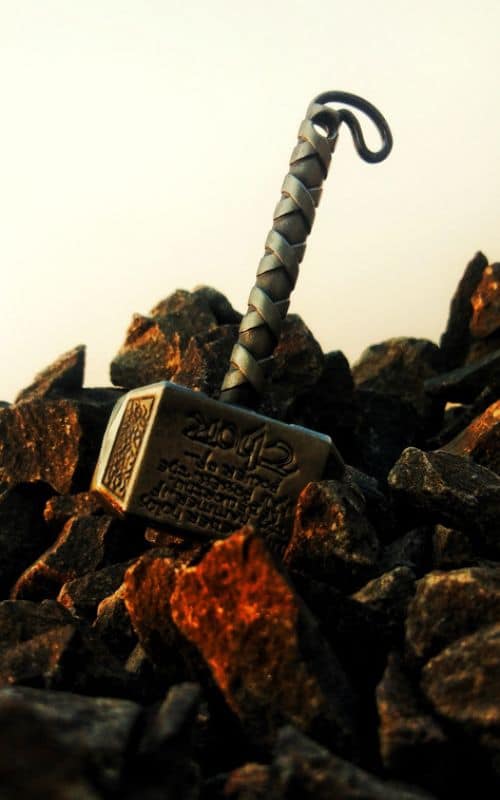The MCU describes Thanos as a “genocidal warlord from Titan.” As a powerful god-like being, Thanos became a “world conqueror,” and an “intergalactic warlord.” He is a dangerous and feared villain.
However, the MCU also points out how Thanos believed he could bring stability to the universe and save other planets from the Titan’s collapse from overpopulation. The catch was that Thanos also believed that half the population of the universe needed to be wiped out to achieve this goal.
These plot lines run into the movie Avengers: Endgame, and help frame a key moment when Thanos may have lifted Thor’s hammer. Did Thanos lift Mjolnir in Endgame?
Reading into Thanos the villain and Thanos the self-proclaimed savior helps address this question.
Contents
Did Thanos lift Mjolnir in Avengers: Endgame?
Once Thanos got the Infinity Stones, he seemed unbeatable, and this premise set up the last Avengers movie.
In Avengers: Endgame, the team of superheroes reversed Thanos’s snap. Thor temporarily decapitated him, but Thanos returned to fight the Avengers in the Battle of Earth.
During this battle, Captain America lifted Mjolnir, saved Thor, and fought Thanos. Viewers thought they saw Thanos grab Mjolnir, albeit briefly, and toss the hammer away.
Did Thanos lift Mjolnir? If he did, then he would prove that he was “worthy” to do so.
On closer inspection of this pivotal scene, Thanos appears to block a potential blow with Mjolnir by grabbing Captain America’s hand. Thanos did not grab the hammer itself.

Thanos did lift Stormbreaker in the movie, but this is not the same thing as wielding Mjolnir.
Marvel fans agree with this viewpoint. Thanos could lift Stormbreaker because he does not have to be worthy to do so, just powerful. And, Thanos stopped Mjolnir by grasping Captain America’s hand.
Because Thanos is so large, he grabs the Captain’s hand and part of his wrist. He stopped the wielder of the weapon, not the hammer itself.
If Thanos did not lift Mjolnir, does that mean he could not do so?
Can Thanos Lift Mjolnir? Is He Worthy?

Since Thanos grabbed Captain America’s hand, instead of Mjolnir, we may conclude that Thanos thought he was not worthy of holding the hammer, and would not be able to lift it.
Thanos is the premier Marvel villain. He has been described as “a homicidal maniac” who thrives on wiping out half the universe. If he is so narcissistic and evil, then he would not be worthy to lift Mjolnir.
However, as the above article indicates, Thanos thinks he is noble and worthy, and his beliefs about himself could allow him to lift the magical hammer.
By the way Mjolnir was forged, the hammer detects whether someone is worthy to use it. The hammer has enchanted properties that allow this detection, or it can “tell” whether or not the wielder is worthy.
A main criterion for the decision is the potential wielder’s selflessness. For example, Vision lifts the hammer to mobilize and inspire the Avengers to defeat Ultron in the Age of Ultron.
The first viewpoint on Thanos sees him as selfish and unworthy, while this second argument posits that Thanos believes he is in the right and is worthy.
Thanos believes himself to be worthy in a Malthusian way. The 18th to 19th-century English economist, Thomas Malthus also saw unchecked population growth as the leading problem that would result in human misery.
Thanos’s thinking corresponds with Malthus’s. Both thought of themselves as in the right, so Thanos may have grounds for lifting Mjolnir.
An in-between, third viewpoint is that Thanos may not have known whether he was worthy or not. And, when the hammer gets thrown in the Battle of Earth, it’s because Thanos landed a punch on Captain America.
Thanos may not even be thinking about the hammer’s enchantment, and more about defeating Captain America. So, he may or may not be worthy.
These are three viewpoints for determining whether Thanos can lift Mjolnir. Fans can decide which one holds the most weight. But given Thanos’s track record, the first seems most likely.
Who Else Can Lift Mjolnir?

Odin, Thor’s father, lifted Mjolnir before Thor. So did his daughter, Thor’s sister, Hela–she was the owner of it before Odin installed its protective enchantment. In Thor: Ragnarok, Hela proved she could still wield Mjolnir.
As noted above, Vision could lift Mjolnir because of his selfless motivations. By contrast, someone like Iron Man could not lift Mjolnir because he did have a good purpose for doing so.
Captain America first moved the hammer slightly in Age of Ultron, and fully wielded it in Endgame. He proved himself worthy with his willingness to sacrifice himself.
In the latest film Thor: Love and Thunder, Thor lifts and wields Mjolnir with ease. Once Thor lost the ability to wield the hammer, it transferred to Jane Foster.

She proved herself worthy with her compassion, helping others, and self-sacrifice.
Marvel comics open up who can lift Mjolnir on a broader basis. The Hulk, for example, lifts it in the Avengers Assemble 2012 issue. Captain America lifts it in multiple issues.
The Marvel comic character Beta Ray Bill was the first to lift Mjolnir after Thor. He was deemed worthy even after defeating Thor in battle.
Quite a few characters lifted Mjolnir, and it tends to come from an inner quality. So, maybe, the argument about Thanos’s self-reflection could hold.
Thanos and Mjolnir
Based on Endgame, Thanos did not lift Mjolnir. He grabbed Captain America’s wrist and the hammer went flying when he hit the Captain.
Thanos may be worthy to hold Mjolnir. But more likely, given his destruction and self-absorption, he could not hold the enchanted hammer.
Other Marvel characters have proven themselves worthy to wield the hammer, the most recent being Jane Foster. Who else will prove themselves worthy?

Todd Wahlstrom is a creative and analytical freelance writer and life-long Star Wars fan who has expanded into writing about the Marvel Cinematic Universe. He has written about recent shows such as The Mandalorian and Andor and classic topics like Darth Vader, the Jedi, and Boba Fett. His recent articles include the MCU’s Iron Man, Captain America, and Thor. Todd is the author of a non-fiction book, holds a Ph.D. in history, and enjoys hiking, running, and reading about science.
